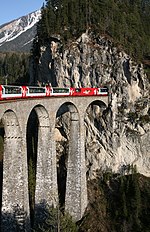The Glacier Express (GEX) is a direct train connecting railway stations of the two major mountain resorts of Zermatt and St. Moritz via Andermatt in the central Swiss Alps. The train is not an "express" in the sense of being a high-speed train, but rather, in the sense that it provides a one-seat ride for an 8-hours-long end-to-end 291 km (181 mi) journey, and omits stops made by local trains. The Glacier Express is known as the slowest express train in the world. As St. Moritz and Zermatt are home to two well-known mountains, the Glacier Express is also said to travel from Matterhorn to Piz Bernina.The journey from Zermatt starts at the dead end of an Alpine valley, the Mattertal, just below the world-renowned Matterhorn at an elevation of 1,606 m (5,269 ft) before it descends to the huge valley of the Valais in Brig. It traverses the 291-kilometre-long (181 mi) journey through the center of the Swiss Alps, over 291 bridges, through 91 tunnels, such as the 15.4 km-long (9.6 mi) Furka Tunnel at an elevation of 1,500 m (4,900 ft) to circumvent the Furka Pass, makes an intermediate stop at Andermatt on a secluded high Alpine valley, just to traverse its highest point on the Oberalp Pass at 2,033 m (6,670 ft) in order to descend to its lowest point at Chur at 585 m (1,919 ft). From Chur, the capital of the canton of Graubünden, the GEX backtracks to higher altitudes again in order to reach the resort St. Moritz in a further valley to the south. Previously, before traversing the Albula Range by a tunnel at 1,800 metres (5,900 ft), in Filisur travelers can change to a connecting train to reach Davos to the east.
Since 2017, the train is operated by the Glacier Express AG, a cooperation jointly owned by the former operators Matterhorn Gotthard Bahn (MGB) and Rhaetian Railway (RhB). For much of its journey, it also passes along and through the World Heritage Site known as the Rhaetian Railway in the Albula / Bernina Landscapes.
The first Glacier Express started on 30 June 1930 at 07:30 in Zermatt. Initially, it was operated by three railway companies: the Visp-Zermatt-Bahn (VZ), the Furka Oberalp Bahn (FO), and the Rhätische Bahn (RhB). Since 2003, the train has been operated by Rhätische Bahn (RhB) and the Matterhorn Gotthard Bahn (MGB), which arose from a merger between the BVZ and the FO. Since 2017 the Glacier Express AG, owned by the two former operators, runs the train of the same name.
The entire line is metre gauge (narrow gauge), with 23.9 kilometres (14.9 mi) using the rack-and-pinion system both for ascending steep grades and to control descent.










